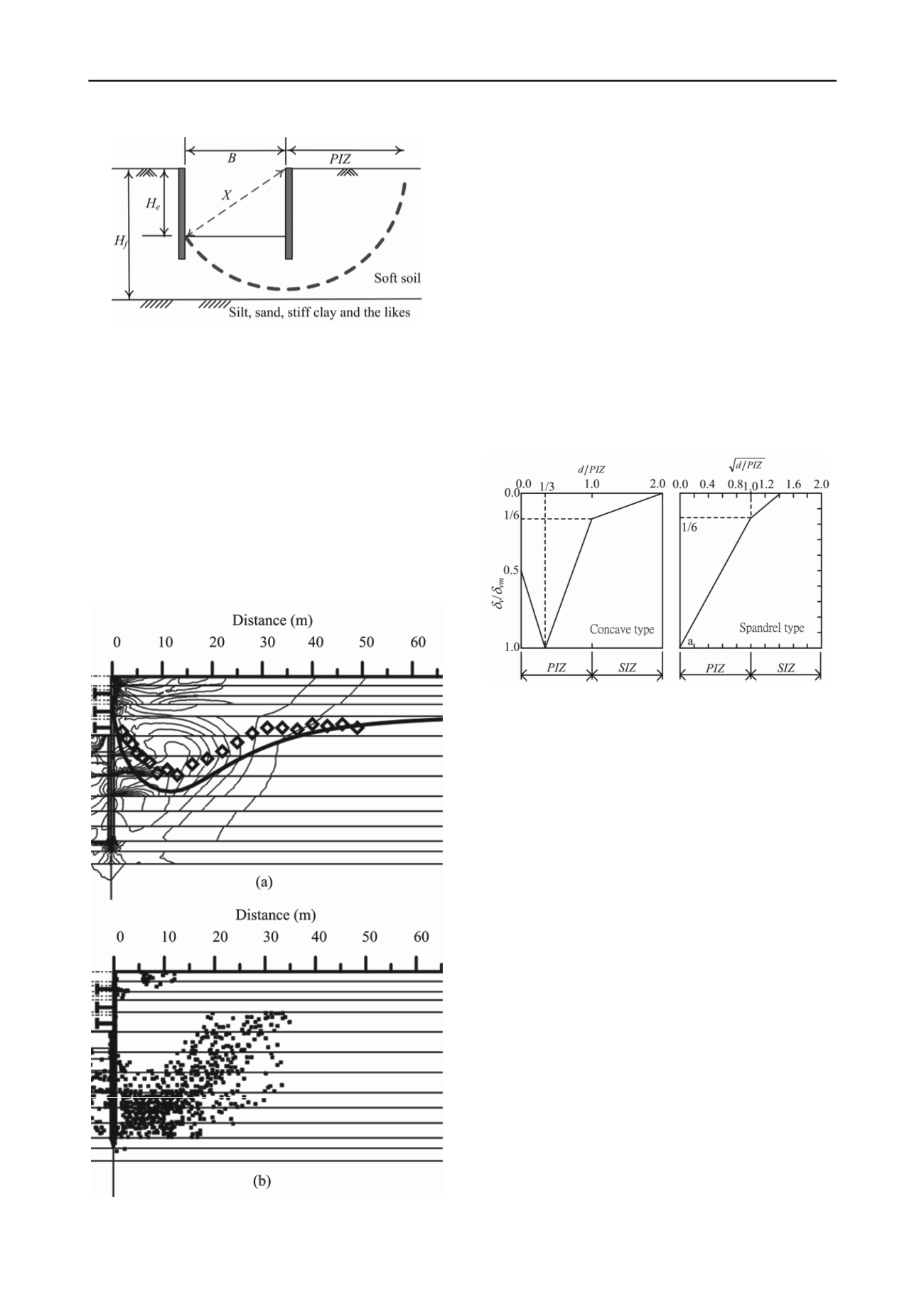
2065
Technical Committee 207 /
Comité technique 207
Figure 5. Basal heave failure mode and PIZ.
Comparing Eq. 3 and Figure 5 may show that the
PIZ
matches the failure zone or potential failure zone. The
PIZ
also
matches the strain contours from the analysis of the TNEC
excavation at stage 7 (
H
e
=11.8 m) and that of the plastic-points
when the strength is reduced to induce basal heave (Figure 6).
This is because the strain in the
PIZ
should be very large, which
in turn induces a relatively large settlement. Therefore, for
excavation in soft clay, the
PIZ
is assumed to be the potential
basal heave zone but limited by the non-soft clay, such as silt,
sand etc (Figure 5). For simplification, (
B
2
+
H
2
)
1/2
in Eq. 3 is
replaced with the excavation width,
B
. Eq. 3 is thus rewritten as
BH
PIZ
f
,
min
1
(5)
where
H
f
is the thickness of the soft clay.
Figure 6. Excavation at Stage 7 for TNEC (a) Strain contours (b) Plastic
points when the strength is reduced to cause basal heave.
The relationship in Eq. 4 indicates that the
PIZ
matches the
active zone based on two times the excavation depth. This is
because when excavation begins, the wall moves toward the
excavation zone and the active zone also occurs behind the wall.
Based on the stability analysis, the embedment depth of the wall
is usually equal to the excavation depth. The
PIZ
is coincident
with the active failure zone but limited by the rock-like soil. The
above equation can be rewritten as
g
e
HH
PIZ
, 2min
2
(6)
where
H
g
is the depth of rock-like soil.
Both
PIZ
1
and
PIZ
2
are the failure zone or potential failure
zones. Therefore, the
PIZ
is the maximum of the potential
failure zones. The method for predicting concave and spandrel
types of ground settlement by Hsieh and Ou (1998) is then
modified, in which the
PIZ
derived in this study replaces the
2
H
e
, as shown in Figure 7. Details of the derivation can be
found in Ou and Hsieh (2011).
Figure 7. The proposed method for predicting the ground surface
settlement.
4 VERIFICATION
The TNEC case history and the ground settlement obtained
from finite element analysis of the hypothetical excavation with
the 80 thick are used for verification. In the TNEC case history,
at stage 5, 2
H
e
=17.2 m. If the cobble-gravel soil is regarded as a
rock-like soil,
H
g
=46 m. Concerning the active failure zone,
PIZ
2
=17.2 m. With the depth of the bottom of the soft clay (
H
f
)
being 37.5 m, for the potential basal heave failure mode,
PIZ
1
=
37.5 m. Thus, the
PIZ
is 37.5 m. At stage 7, 2
H
e
=23.6 m,
H
g
=46 m,
PIZ
2
=23.6 m;
B
=40 m,
H
f
=37.5 m,
PIZ
1
=37.5 m. Thus,
the
PIZ
is 37.5 m. Similarly, the
PIZ
at the final stage (2
H
e
=39.4
m), is inferred to be 39.4 m. Figure 8 show the comparison
between the proposed method (Ou and Hsieh 2011), Hsieh and
Ou (1998) and Clough and O’Rourke (1990). The proposed
method satisfactorily conforms to the field measurements, while
those from other two methods are not.
In the hypothetical excavation with the 80 m thick soft clay,
the excavation depths at stages 5, 7 and final are also 8.6, 11.8
and 19.7 m, respectively. The excavation width=40m. The hard
soil is located at 80 m. Using the method similar to those in the
TNEC case, the estimated
PIZ
for stages 5, 7 and final are all
equal to 40m. Figure 9 shows the comparison of settlement
obtained from the USC analysis with those from the three
methods. The proposed method is able to give a more
reasonable prediction in the settlement of PIZ than the other two
methods.


